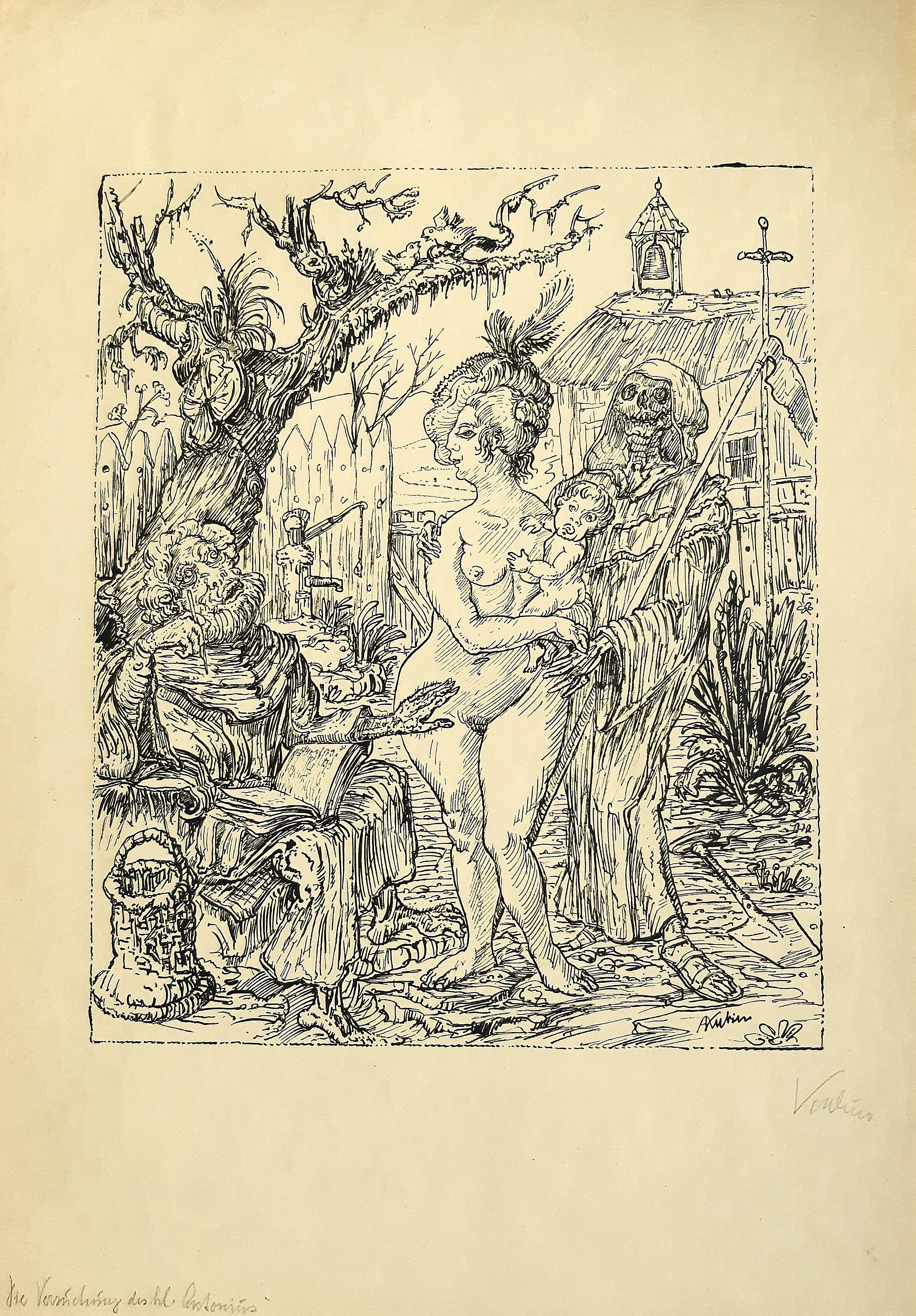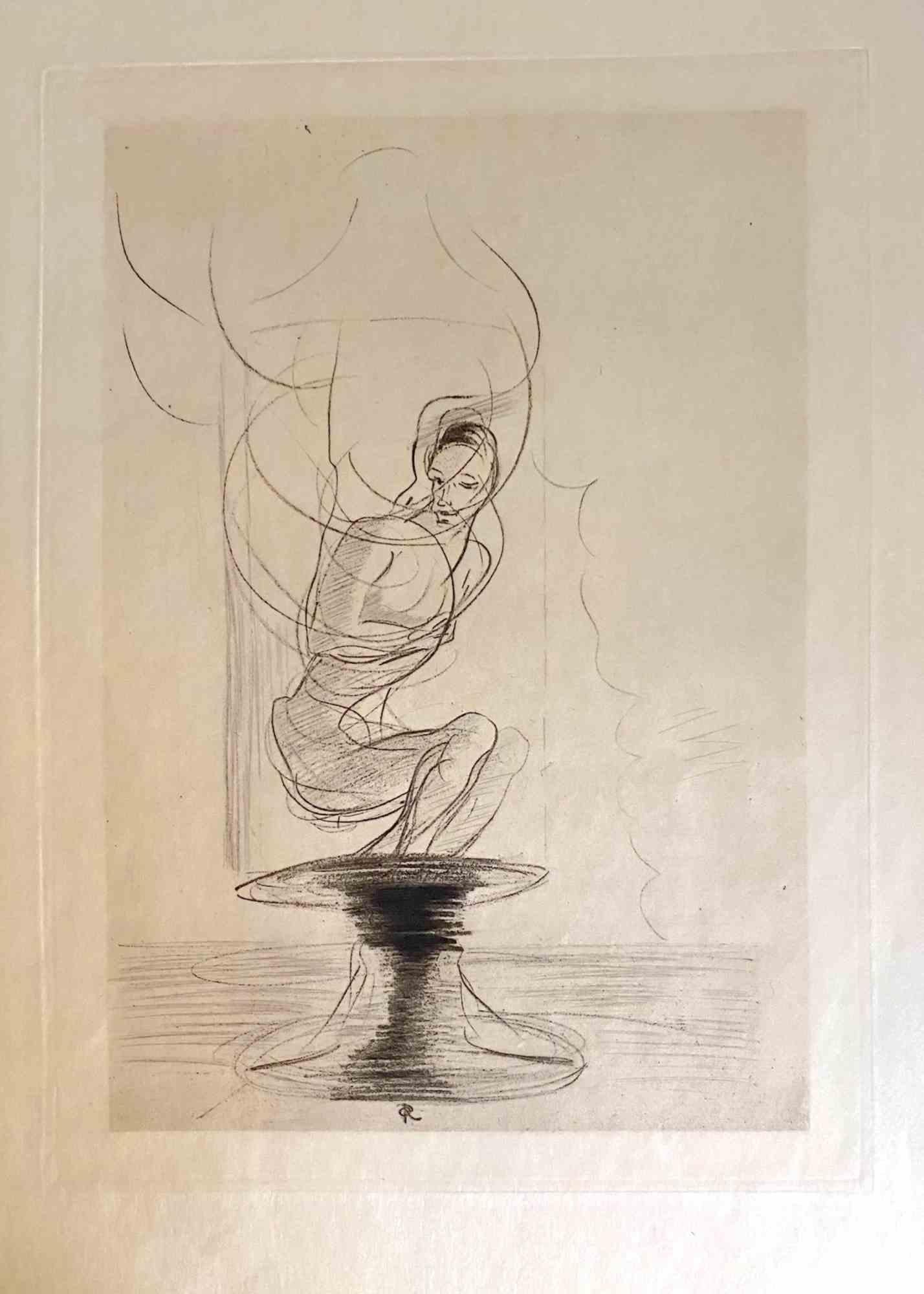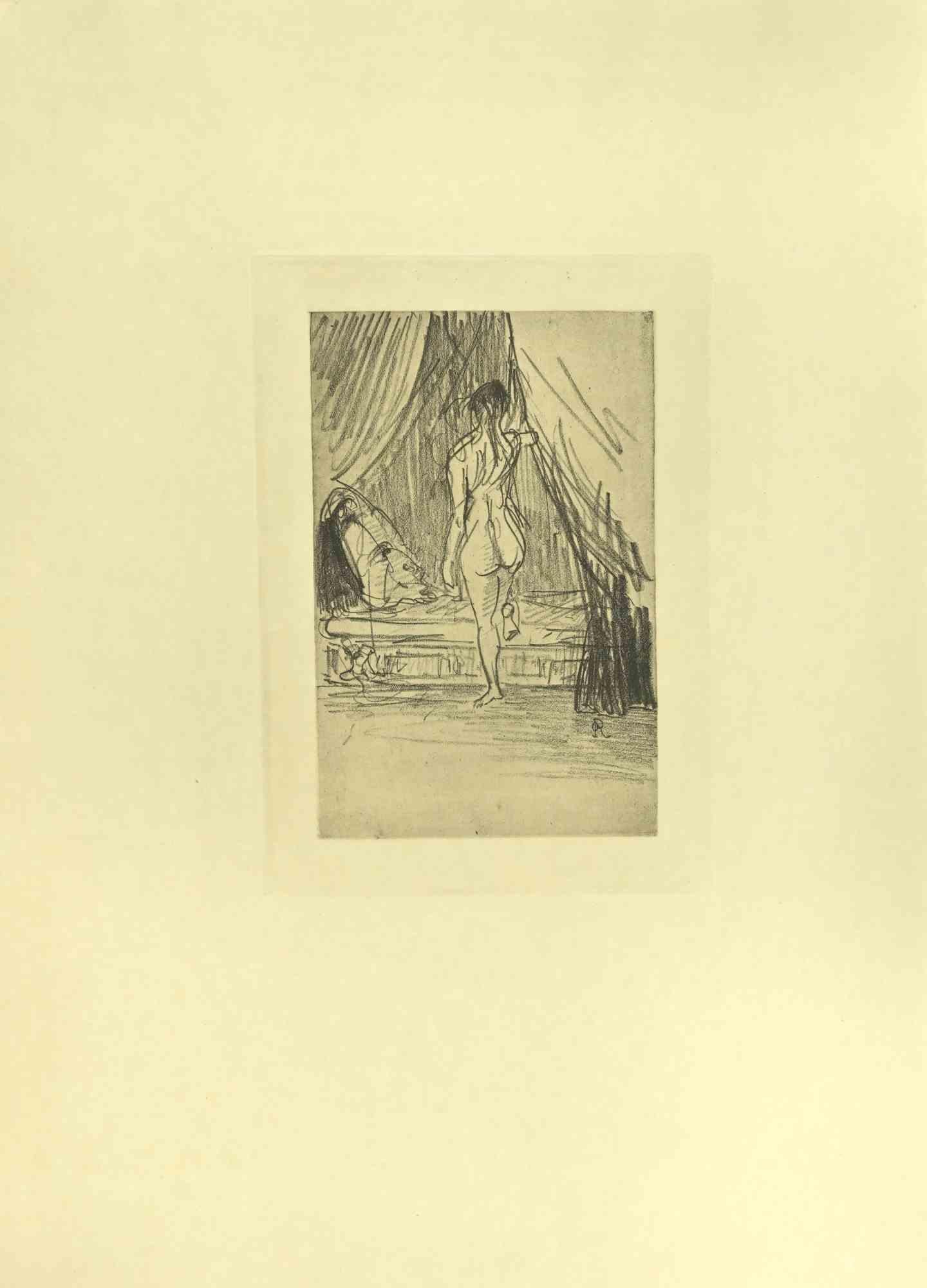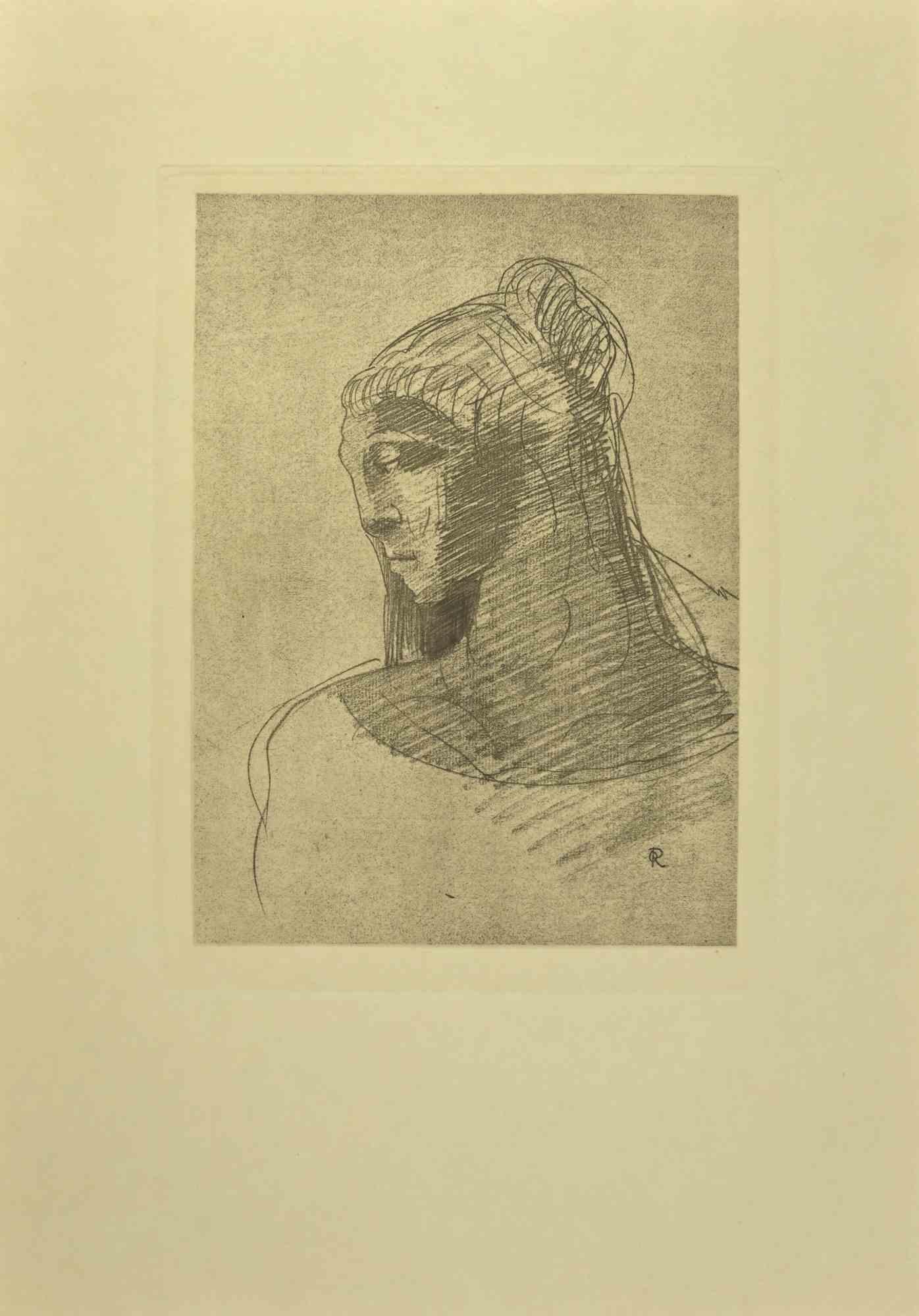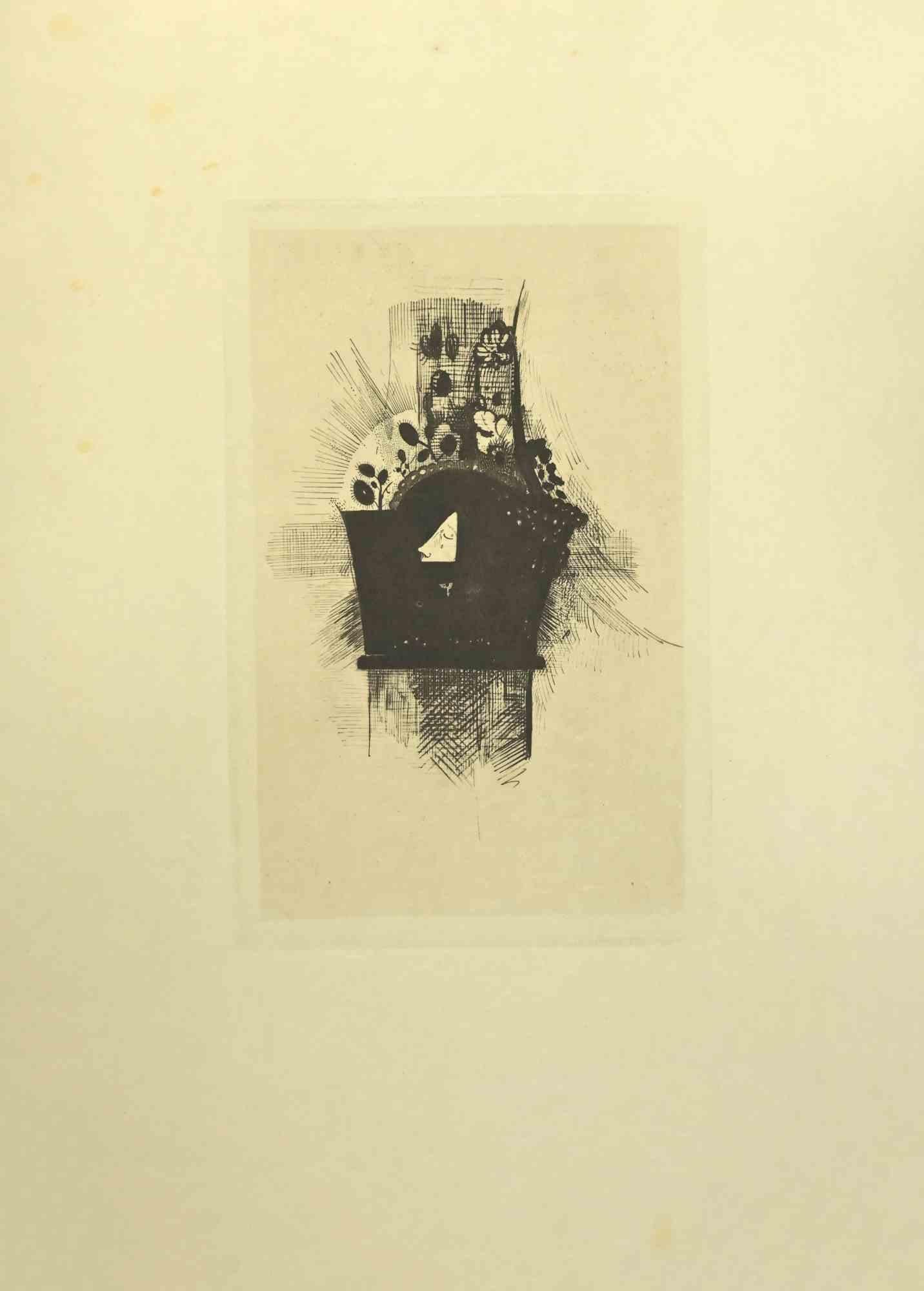Bruno HérouxKriegsnotspende für Leipzig - Etching by Bruno Héroux - 19161916
1916
About the Item
- Creator:Bruno Héroux (1868 - 1944, German)
- Creation Year:1916
- Dimensions:Height: 21.58 in (54.8 cm)Width: 14.97 in (38 cm)Depth: 0.04 in (1 mm)
- Medium:
- Movement & Style:
- Period:
- Condition:Insurance may be requested by customers as additional service, contact us for more information.
- Gallery Location:Roma, IT
- Reference Number:
Bruno Héroux
Louis Carl Bruno Héroux was a German painter from a Huguenot family and son of an engraver, Bruno Héroux, who follows the teachings of the Hochschule für Grafik und Buchkunst (HGB) in Leipzig, where he excels in xylography very quickly. From 1900–10, Héroux exhibited his paintings and engravings at the Salon of French Artists in Paris and obtained the Honorable Mention in 1906. His style, close to symbolism, evolved to the Jugendstil and was praised by an artist like Max Klinger. Héroux was soon at the center of the Leipzig School (Leipziger Künstlervereins) and some of his drawings were used to decorate buildings in Leipzig. He is the author of several hundred original engravings (some of which, erotic, are now very popular), and illustrated a large number of books.
- ShippingRetrieving quote...Ships From: Rome, Italy
- Return PolicyA return for this item may be initiated within 14 days of delivery.
- Die Versuchung des Heiligen Antonius - Original Lithograph by A. Kubin - 1922By Alfred KubinLocated in Roma, ITDie Versuchung des Heiligen Antonius is an original lithograph on simili japanese paper, realized by Alfred Kubin in 1922, Hand-signed, edition of 100 copies. Ref.: Arnason & Wheel...Category
1920s Symbolist Figurative Prints
MaterialsLithograph
- Illustration from the Series "Les Fleurs du Mal" after Odilon Redon - 1923By Odilon RedonLocated in Roma, ITIllustration from the series "Les Fleurs du Mal" is an etching print realized after Odilon Redon and published by Henri Felury in 1923. Monogrammed on the plate. Good conditions. ...Category
1920s Symbolist Figurative Prints
MaterialsLithograph
- Illustration from the series "Les Fleurs du Mal" after Odilon Redon - 1923By Odilon RedonLocated in Roma, ITIllustration from the series "Les Fleurs du Mal" is an etching print realized after Odilon Redon and published by Henri Felury in 1923. Monogrammed in the plate. Good conditions. ...Category
1920s Symbolist Figurative Prints
MaterialsLithograph
- Illustration from the series "Les Fleurs du Mal" after Odilon Redon - 1923By Odilon RedonLocated in Roma, ITIllustration from the series "Les Fleurs du Mal" is an etching print realized after Odilon Redon and published by Henri Felury in 1923. Monogrammed on the plate. Good conditions. ...Category
1920s Symbolist Figurative Prints
MaterialsLithograph
- Illustration from the Series "Les Fleurs du Mal" after Odilon Redon - 1923By Odilon RedonLocated in Roma, ITIllustration from the series "Les Fleurs du Mal" is an etching print realized after Odilon Redon and published by Henri Felury in 1923. Monogrammed on the plate. Good conditions. ...Category
1920s Symbolist Figurative Prints
MaterialsLithograph
- Illustration from the Series "Les Fleurs du Mal" after Odilon Redon - 1923By Odilon RedonLocated in Roma, ITIllustration from the series "Les Fleurs du Mal" is an etching print realized after Odilon Redon and published by Henri Felury in 1923. Monogrammed on the plate. Good conditions wi...Category
1920s Symbolist Figurative Prints
MaterialsLithograph
- "Harmony" Colorful Zebras Lithograph by Chinese Artist Jiang Tie-Feng #35/75Located in Pasadena, CAThe serigraph on paper signed and numbered 35/75 rests in a black lacquer frame. It features a multicolor zebras gathering, one very thought after subject from this artist. Chinese A...Category
1970s Symbolist Animal Prints
MaterialsLithograph
- Le Fondeur Paris [Steel Worker]By Eugène CarrièreLocated in New York, NYCarriere, Eugene. Le Fondeur, Paris 1900 [Steel Worker], Color lithograph. Ref: Das Fruhe Plakat 134. 51 x 34 3/4 inches. Eugène Anatole Ca...Category
Early 1900s Symbolist Figurative Prints
MaterialsLithograph
- Untitled (Mother and Child)By Maurice DenisLocated in Myrtle Beach, SCMaurice Denis, Untitled (Mother and Child), lithograph, 1897, edition not stated. Signed in the stone, lower right. Annotated in linotype 'MAURICE DENIS, ORIGINAL LITHOGRAPHIE PAN III' in the lower left sheet corner. A fine, atmospheric impression, in warm, dark gray ink, on buff wove paper, with full margins (2 1/2 to 1 3/4 inches); a small discoloration in the bottom left sheet corner, otherwise in good condition. Image size 8 5/8 x 6 7/8 inches; sheet size 13 7/8 x 10 5/8 inches. As published in 'Pan', the leading German magazine of the period devoted to art and literature. Matted to museum standards, unframed. Collection: Los Angeles County Museum of Art. Reproduced: German Expressionist Prints...Category
1890s Symbolist Figurative Prints
MaterialsLithograph
- Abel Pann Israeli Bezalel School Lithograph Judaica Biblical Print Jewish ArtBy Abel PannLocated in Surfside, FLAbel Pann (1883–1963) was a European Jewish painter who settled in the Talpiot neighborhood of Jerusalem in the early twentieth century and taught at the Bezalel Academy of Art under Boris Schatz. Abba Pfeffermann (later Abel Pann), born in Latvia or in Kreskowka, Vitebsk, Belarus, was a European Russian Jewish art...Category
Mid-20th Century Symbolist Figurative Prints
MaterialsLithograph
- Abel Pann Israeli Bezalel School Lithograph Judaica Biblical Print Jewish ArtBy Abel PannLocated in Surfside, FLAbel Pann (1883–1963) was a European Jewish painter who settled in the Talpiot neighborhood of Jerusalem in the early twentieth century and taught at the Bezalel Academy of Art under Boris Schatz. Abba Pfeffermann (later Abel Pann), born in Latvia or in Kreskowka, Vitebsk, Belarus, was a European Russian Jewish artist who immigrated to Ottoman Palestine and settled in Jerusalem. He was married to Esther Nussbaum. Pann's youngest son was killed in the 1947–1949 Palestine war. After that loss, he turned to painting scenes of the Holocaust. He died in Jerusalem in 1963. Pann studied the fundamentals of drawing for three months with the painter Yehuda Pen of Vitebsk, who also taught Marc Chagall. In his youth, he traveled in Russia and Poland, earning a living mainly as an apprentice in sign workshops. In 1898 he went south to Odessa, where he was accepted into the Academy of Fine Arts. In 1903, he was in Kishinev, where he documented the Kishinev pogrom with drawings; an effort that is thought to have contributed to his self-definition as an artist who chronicles Jewish history. Still in 1903, he moved to Paris, where he rented rooms in La Ruche, a Parisian building (which still exists) where Modigliani, Chagall, Chaim Soutine and other Jewish artists also lived. Pann studied at the French Academy under William-Adolphe Bouguereau. He earned his living primarily by drawing pictures for the popular illustrated newspapers of the era. In 1912, Boris Schatz, founder and director of the Bezalel Academy of Arts and Design visited Pann in Paris and invited him to come work in Jerusalem. In 1913, after traveling in Southern Europe and Egypt, Pann arrived in Jerusalem, where he had decided to settle for life. Pann went to see Schatz and it was decided that he would head the painting department at the Bezalel Academy for several months while Schatz embarked on an extensive overseas fund-raising trip. According to Haaretz art critic Smadar Sheffi, a work form this period with the simple title "Jerusalem" shows a cluster of buildings at sunset "with a sky in blazing orange." The painting is "more expressive and abstract that is typical of his work," and Sheffi speculates that "the encounter with the city" of Jerusalem was a "strong emotional experience" for the artist. Pann returned to Europe to arrange his affairs before moving permanently to the British Mandate of Palestine, but was caught on the continent by World War I. Pann's wartime paintings would prove to be among "the most important" of his career. He made many posters to support the French war effort. He also made a series of fifty drawings showing the extreme suffering of Jewish communities caught in the fighting between Germany, Poland and Russia. Art critic Smadar Sheffi regards them as "the most important part of his oeuvre." These "shocking" drawings put modern viewers in mind of depictions of the Holocaust. Pann's drawings were intended as journalistic documentation of the fighting and were successfully exhibited in the United States during the War. According to Pann's autobiography, the Russians, who were allied with the French, refused to allow a wartime exhibition of the drawings in France. According to The New York Times, the drawings were published in Paris during the war, but the government intervened to block their distribution on the grounds that they "reflected damagingly upon an ally" (Russia). Upon his return to Jerusalem in 1920, Pann took up a teaching position at the Bezalel Academy and wrote that he was about to embark on his life-work, the painting and drawing of scenes from the Hebrew Bible. He returned briefly to Vienna, where he met and married Esther Nussbaum and purchased a lithographic press, which the couple brought home to Jerusalem. Pann began work on a series of lithographs intended to be published in an enormous illustrated Bible, and although that series was never completed, he is widely admired for the series of pastels inspired by Bible stories that he began in the 1940s. The iconography of these works is linked to the 19th century orientalism. He was part of a movement of contemporary Jewish artists interested in Biblical scenes, including Ephraim Moses Lilien...Category
Mid-20th Century Symbolist Figurative Prints
MaterialsLithograph
- Abel Pann Israeli Bezalel School Lithograph Judaica Biblical Print Jewish ArtBy Abel PannLocated in Surfside, FLAbel Pann (1883–1963) was a European Jewish painter who settled in the Talpiot neighborhood of Jerusalem in the early twentieth century and taught at the Bezalel Academy of Art under...Category
Mid-20th Century Symbolist Figurative Prints
MaterialsLithograph
